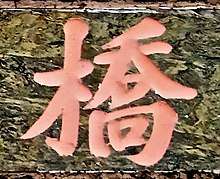橋
| ||||||||
Translingual
Han character
橋 (radical 75, 木+12, 16 strokes, cangjie input 木竹大月 (DHKB), four-corner 42927, composition ⿰木喬)
Derived characters
- 𡳯, 𧂼
References
- KangXi: page 553, character 1
- Dai Kanwa Jiten: character 15526
- Dae Jaweon: page 941, character 17
- Hanyu Da Zidian: volume 2, page 1292, character 9
- Unihan data for U+6A4B
Chinese
| trad. | 橋 | |
|---|---|---|
| simp. | 桥 | |
Glyph origin
| Historical forms of the character 橋 | |
|---|---|
| Shuowen Jiezi (compiled in Han) | Liushutong (compiled in Ming) |
| Small seal script | Transcribed ancient scripts |
 |
 |
| Characters in the same phonetic series (喬) (Zhengzhang, 2003) | |
|---|---|
| Old Chinese | |
| 驕 | *krew |
| 嬌 | *krew, *krewʔ, *ɡrew |
| 憍 | *krew, *kʰrew |
| 穚 | *krew |
| 鷮 | *krew, *ɡrew |
| 蕎 | *krew, *ɡrew |
| 喬 | *krew, *ɡrew |
| 簥 | *krew |
| 撟 | *krew, *krewʔ |
| 矯 | *krewʔ |
| 鱎 | *krewʔ |
| 敽 | *krewʔ |
| 蟜 | *krewʔ, *ɡrew |
| 譑 | *krewʔ, *kʰews |
| 蹻 | *krewʔ, *kʰew, *ɡrew, *kewɢ, *ɡewɢ |
| 繑 | *kʰew |
| 鞽 | *kʰrew |
| 趫 | *kʰrew, *ɡrew |
| 嘺 | *ɡew |
| 橋 | *ɡrew |
| 僑 | *ɡrew |
| 鐈 | *ɡrew |
| 毊 | *ɡrew, *qʰrew |
| 轎 | *ɡrew, *ɡrews |
| 嶠 | *ɡrews |
| 獢 | *qʰrew |
| 屩 | *kewɢ |
Phono-semantic compound (形聲, OC *ɡrew) : semantic 木 (“wood”) + phonetic 喬 (OC *krew, *ɡrew).
Pronunciation
Definitions

橋
- bridge (over a river)
- bridge-like object: footbridge; beam; crosspiece
- (Cantonese) idea
- A surname.
Compounds
|
|
|
Japanese
Readings
Alternative forms
- (variant) 𣘺 [U+2363a]
- (variant) 槗 [U+69d7]
Etymology
| Kanji in this term |
|---|
| 橋 |
| はし Grade: 3 |
| kun’yomi |
/pasi/ → /ɸasi/ → /hasi/
From Old Japanese, originally indicating either the area between two things, or a connection between two things.[1]
Cognate with 階 (hashi, “stairs from a garden up to the house”), both cognate with root hasa indicating the narrow area between two things, as in 狭間 (“narrow gap between two things”, classical hasama, modern hazama) or 挟む (hasamu, “to put between two things that are close together, to squeeze between two things”).[1] Cognate also with root hoso indicating the narrowness of a thing itself, as in 細い (hosoi, “narrow, slender”), 細める (hosomeru, “to narrow something, to make something narrow”).
Noun
- that which is constructed to connect two points for the purpose of transportation: a bridge
- 794, Shin'yaku Kegonkyō Ongi Shiki (page 16):[5]
- 旋澓 [...] 梁力將反橋也二字波之
- 794, Shin'yaku Kegonkyō Ongi Shiki (page 43):[5]
- 橋梁 上波之下宇都波利
- 794, Shin'yaku Kegonkyō Ongi Shiki (page 16):[5]
- a bridge-like walkway or corridor between two buildings in a manor, palace, castle, or similar structure
- a person who acts as a bridge between different people: a mediator, a go-between
Synonyms
References
- 1988, 国語大辞典(新装版) (Kokugo Dai Jiten, Revised Edition) (in Japanese), Tōkyō: Shogakukan
- 1998, NHK日本語発音アクセント辞典 (NHK Japanese Pronunciation Accent Dictionary) (in Japanese), Tōkyō: NHK, ISBN 978-4-14-011112-3
- 2006, 大辞林 (Daijirin), Third Edition (in Japanese), Tōkyō: Sanseidō, ISBN 4-385-13905-9
- 1997, 新明解国語辞典 (Shin Meikai Kokugo Jiten), Fifth Edition (in Japanese), Tōkyō: Sanseidō, ISBN 4-385-13143-0
- Yoshinori Kobayashi, Kojisho Ongi Shūsei 1: Shin'yaku Kegonkyō Ongi Shiki (in Japanese), Kyūko Shoin (published 1978; original text from 794), ISBN 4-7629-3088-1.
Korean
Hanja
橋 • (gyo) (hangeul 교)
- This term needs a translation to English. Please help out and add a translation, then remove the text
{{rfdef}}.
Vietnamese
Han character
橋 (kiều)
- This term needs a translation to English. Please help out and add a translation, then remove the text
{{rfdef}}.